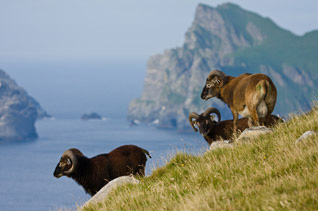|
|
Climate change is shrinking Scotland’s wild Soay sheep despite the evolutionary advantages of having a large body, report researchers writing in the journal Science.
Arpat Ozgul and colleagues tracked changes in body weight and behavior among female members of a population of Soay sheep on Hirta island since 1985 and found that on average, the sheep have been decreasing in size for the last 25 years. To determine the driver of smaller sheep, the researchers then plugged their data into a numerical model that “predicts how a trait such as body size will change over time due to natural selection and other factors that influence survival and reproduction in the wild.” The results suggest that the decrease is primarily an ecological response to environmental variation over the last 25 years, rather than evolutionary change.
 Soay sheep on St. Kilda archipelago. Photo by Arpat Ozgul |
“It’s only in the last few years that we’ve realized that evolution can influence species’ physical traits as quickly as ecological changes can. This study addresses one of the major goals of population biology, namely to untangle the ways in which evolutionary and environmental changes influence a species’ traits,” said Andrew Sugden, Deputy and International Managing Editor at Science.
“Sheep are getting smaller. Well, at least the wild Soay sheep living on a remote Scottish island are. But according to classic evolutionary theory, they should have been getting bigger, because larger sheep tend to be more likely to survive and reproduce than smaller ones, and offspring tend to resemble their parents,” said co-author, Tim Coulson of Imperial College London.
“Our findings have solved a paradox that has tormented biologists for years – why predictions did not match observation. Biologists have realized that ecological and evolutionary processes are intricately intertwined, and they now have a way of dissecting out the contribution of each. Unfortunately it is too early to tell whether a warming world will lead to pocket-sized sheep.”
The researchers say that shorter and milder winters mean lambs do not need to put on as much as weight as they once did in order to survive their first year of life. Even slower-growing lambs now have a chance of surviving. The researchers also found that “younger mothers are physically unable to produce offspring that are as big as they were at birth”.
“The young mum effect explains why Soay sheep have not been getting bigger, as we expected them to,” explained Coulson, “But it is not enough to explain why they’re shrinking. We believe that this is down to climate change. These two factors are combining to override what we would expect through natural selection.”
Arpat Ozgul at al. The Dynamics of Phenotypic Change and the Shrinking Sheep of St. Kilda. Science 2 July 2009